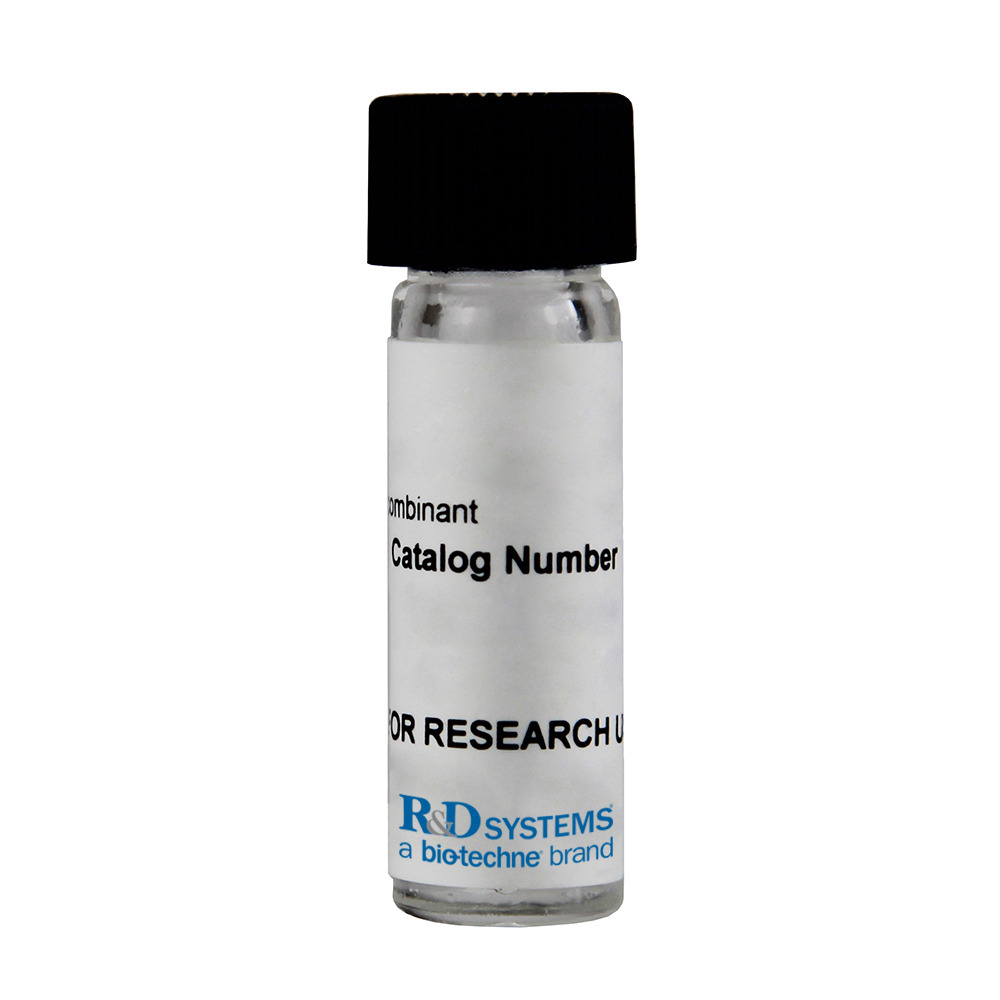Recombinant Human Endostatin Protein, CF
R&D Systems, part of Bio-Techne | Catalog # 1098-ES

Key Product Details
- R&D Systems E. coli-derived Recombinant Human Endostatin Protein (1098-ES)
- Quality control testing to verify active proteins with lot specific assays by in-house scientists
- All R&D Systems proteins are covered with a 100% guarantee
Source
Accession #
Structure / Form
Conjugate
Applications
Product Specifications
Source
His1154-Ser1335, with an N-terminal Met and 8-His tag
Purity
Endotoxin Level
N-terminal Sequence Analysis
Predicted Molecular Mass
SDS-PAGE
Activity
The ED50 for this effect is 0.4-2 μg/mL in the presence of 20 μg/mL of Goat Anti-Human Endostatin Antigen Affinity-purified Polyclonal Antibody (Catalog # AF1098).
Formulation, Preparation and Storage
1098-ES
| Formulation | Lyophilized from a 0.2 μm filtered solution in PBS. |
| Reconstitution |
Reconstitute at 200 μg/mL in PBS.
|
| Shipping | The product is shipped at ambient temperature. Upon receipt, store it immediately at the temperature recommended below. |
| Stability & Storage | Use a manual defrost freezer and avoid repeated freeze-thaw cycles.
|
Background: Endostatin
Endostatin, an endogenous non‑glycosylated inhibitor of endothelial cell proliferation and angiogenesis, is an approximately 181 amino acid (aa), 20 kDa proteolytic fragment of the C‑terminal non‑collagenous domain of type XVIII collagen (1, 2). It is produced and/or trimmed by metalloproteinases such as MMP‑2 and MMP‑9, and cathepsins S, B and L (3, 4). The N‑terminal ~27 aa of Endostatin appear to contain the majority of its activity (4, 5). This region contains three zinc binding sites that are thought to be critical for its anti‑endothelial and anti‑tumor effects, as well as multiple cleavage sites that, when used, can modify its activity (4, 5). Human Endostatin shares 84‑87% aa sequence identity with mouse, rat, bovine and equine Endostatin. Endostatin inhibits endothelial cell growth by inducing cell cycle arrest in G1 phase and initiating apoptosis (1, 2). It is also thought to down‑regulate angiogenesis by blocking VEGF‑induced endothelial cell migration (6, 7). It alters the effect of FGF basic on adhesion and cell motility (8). Endostatin can interact with Transglutaminase 2, heparin, and integrins alpha5 beta1 and alphav beta3, all of which may be secreted by, or expressed on, endothelial cells, and can influence adhesion or migration (9, 10). Endostatin may also be involved with down‑regulation of angiogenesis after establishment of placental circulation in the pregnant uterus (11). Over‑expression in keratinocytes causes delay in healing of excisional wounds, while exogenous systemic Endostatin promotes endothelial and smooth muscle nitric oxide production and decreases blood pressure (12, 13). Since tumor growth and metastasis relies on angiogenesis to provide blood supply, Endostatin is inhibitory for a wide variety of primary and metastatic tumors (5‑8).
References
- Dhanabal, M. et al. (1999) Biochem. Biophys. Res. Commun. 10:345.
- O’Reilly, M.S. et al. (1997) Cell 88:277.
- Nilsson, U.W. et al. (2006) Cancer Res. 66:4789.
- Veillard, F. et al. (2011) J. Biol. Chem. 286:37158.
- Folkman, J. (2006) Exp. Cell Res. 312:594.
- Yamaguchi, N. et al. (2001) EMBO J. 18:4414.
- Ling, Y. et al. (2007) Biochem. Biophys. Res. Commun. 361:79.
- Dixelius, J. et al. (2002) Cancer Res. 62:1944.
- Faye, C. et al. (2010) Biochem. J. 427:467.
- Rehn, M. et al. (2001) Proc. Natl. Acad. Sci. USA 98:1024.
- Pollheimer, J. et al. (2011) Endocrinol. 152:4431.
- Seppinen, L. et al. (2008) Matrix Biol. 27:535.
- Sunshine, S.B. et al. (2012) Proc. Natl. Acad. Sci. USA 109:11306.
Alternate Names
Gene Symbol
UniProt
Additional Endostatin Products
Product Documents for Recombinant Human Endostatin Protein, CF
Product Specific Notices for Recombinant Human Endostatin Protein, CF
For research use only
